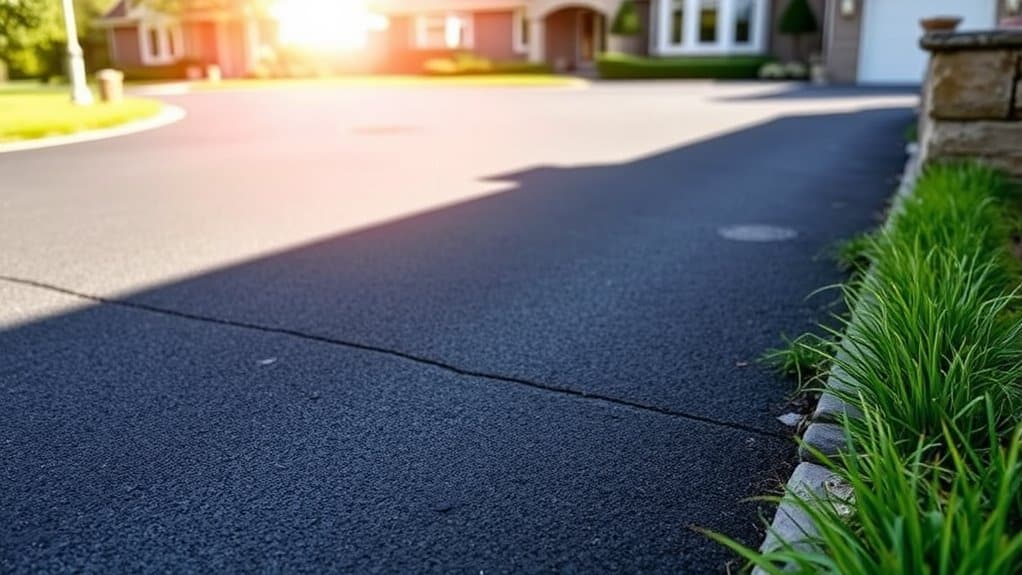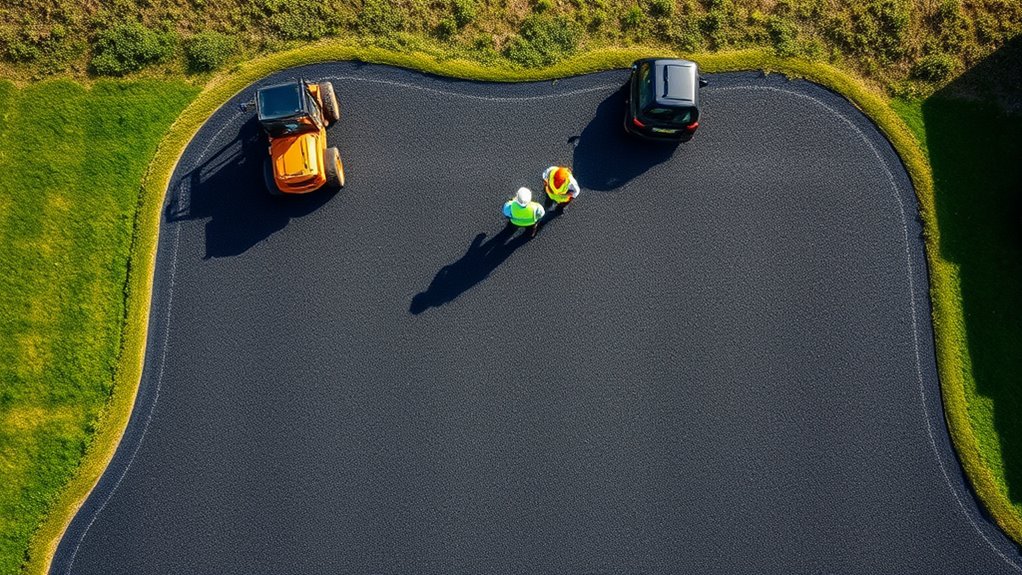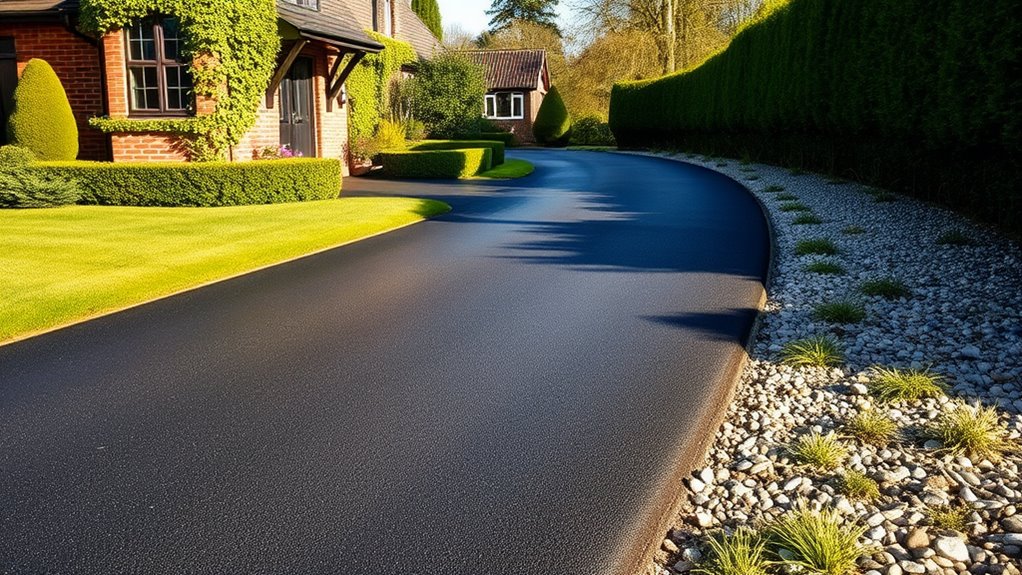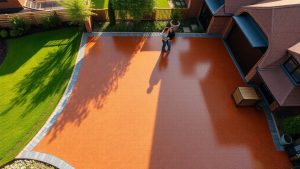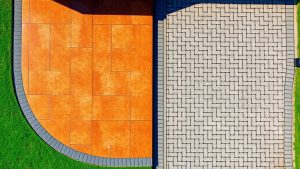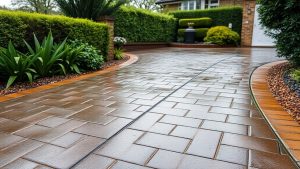To reduce heat absorption in your tarmac driveway during summer, consider applying reflective coatings to reduce sunlight absorption. Planting trees or installing structures for shade can also be beneficial. Using innovative cool pavement materials can help keep surface temperatures down. Ensure proper drainage to avoid standing water and carry out regular inspections to identify any potential issues early. These measures can enhance both the comfort and longevity of your driveway.
Table of Contents
ToggleKey Takeaways
- Apply reflective coatings, such as SunShield, to improve sunlight reflection and keep your tarmac cooler in the summer heat.
- Consider planting trees or putting up shade structures to reduce direct sunlight on the driveway.
- Use water cooling methods, like spraying cold water on the tarmac during the hottest parts of the day, to help lower surface temperatures.
- Ensure proper drainage to prevent standing water, which can retain heat.
- Keep up with regular maintenance, including sealcoating every 2-3 years, to protect your tarmac from UV damage and prolong its life.
Understanding Heat Absorption in Tarmac
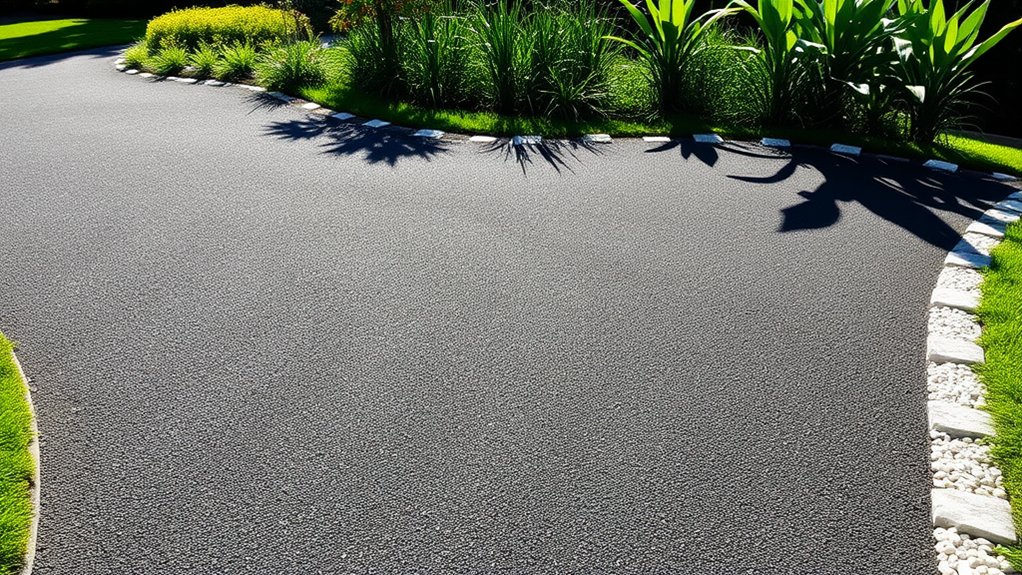
When looking at how tarmac absorbs heat, it’s important to consider what it’s made of and how it behaves.
Tarmac, mainly composed of bitumen, has thermal properties that allow it to soak up sunlight effectively. Its dark colour boosts solar absorption, turning light into heat, which raises surface temperatures, especially in urban areas. Because tarmac has low thermal conductivity, it holds onto heat for longer, worsening the urban heat island effect. Factors such as thickness, weather conditions, and nearby buildings also affect heat retention. In fact, the low thermal conductivity of tarmac means that it absorbs heat faster than it releases it, contributing to elevated temperatures during hot weather.
For effective urban planning, understanding these aspects is crucial. By addressing tarmac’s thermal properties, we can devise strategies to reduce heat absorption, enhancing outdoor comfort and lowering energy use.
Benefits of Reflective Coatings
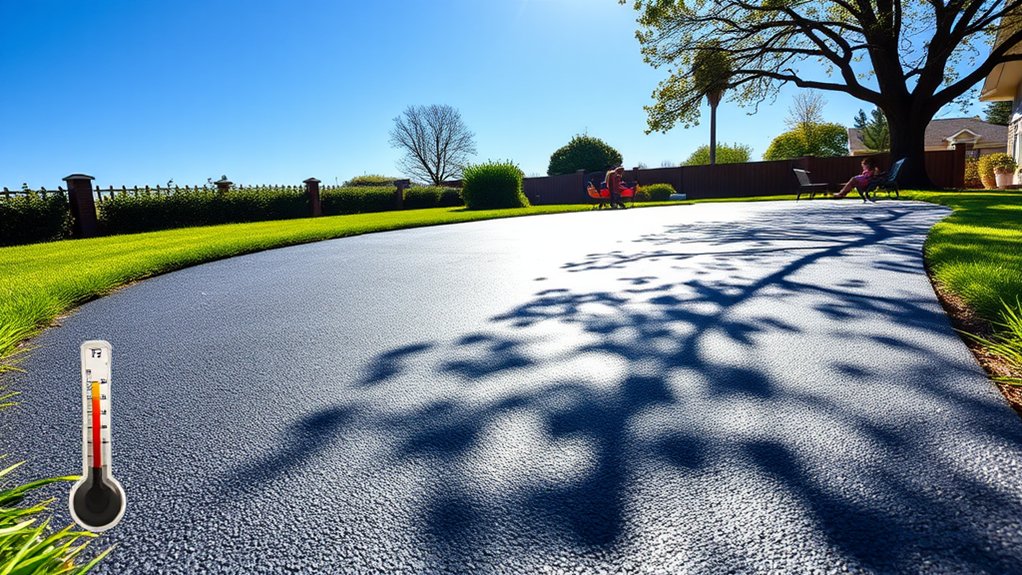
Reflective coatings significantly improve heat reflection, helping to keep your tarmac driveway cooler and more comfortable underfoot. They also enhance the durability of the surface, which means you’ll spend less on repairs over time. In the long run, these coatings offer a cost-effective solution that’s beneficial for both your budget and the environment. Additionally, using a reflective coating like SunShield can prolong the life cycle of your asphalt pavement.
Enhanced Heat Reflection
Enhanced heat reflection significantly boosts the thermal performance of tarmac driveways by using innovative materials that improve surface reflectivity. By applying solar coatings with reflective pigments, you can effectively reduce heat absorption, which helps lower surrounding air temperatures and alleviate the urban heat island effect. Additionally, these coatings reflect up to 85% of sunlight, contributing to a cooler environment and further enhancing energy savings.
| Benefit | Description | Impact on Environment |
|---|---|---|
| Energy Savings | Lower cooling costs for nearby buildings | Cuts greenhouse gas emissions |
| Long-Term Cost Effectiveness | Durable coatings need less frequent reapplication | Reduces waste from replacements |
| Reduced Maintenance | Prolongs the lifespan of pavements | Lowers overall environmental impact |
| Improved Air Quality | Cooler surfaces lead to reduced pollutant levels | Enhances public health |
| Increased Property Value | Cooler driveways enhance property appeal | Supports eco-friendly initiatives |
Improved Surface Durability
Enhanced surface durability is a major benefit of using thermal barrier coatings on tarmac driveways. These coatings can extend the lifespan of asphalt by two to three times, offering significant protection.
They shield the surface from UV rays and thermal stress, which boosts durability. Moreover, they resist damage from salt, oil, and other harmful substances, leading to reduced maintenance.
This improvement helps prevent cracks and ruts, ensuring a smoother surface that can handle heavy traffic. As a result, you’ll face fewer repairs and enjoy longer-lasting driveways, making for a more reliable and sustainable solution.
Investing in these reflective coatings not only safeguards your driveway but also enhances its resilience against environmental factors.
Cost-Effective Long-Term Solution
Using thermal barrier coatings not only enhances the durability of tarmac driveways but also offers a cost-effective long-term solution. Reflective materials help to reduce heat absorption, keeping the surface cooler and preventing damage, which in turn extends its lifespan. This means lower maintenance costs, as you’ll need fewer repairs over time. Moreover, by improving safety and aesthetics, these coatings can also boost your property’s value.
| Benefit | Description |
|---|---|
| Improved Temperature Control | Reduces heat absorption, extending the life of your driveway. |
| Enhanced Safety Features | Minimises heat-related injuries and accidents. |
| Economic Benefits | Lowers long-term maintenance and repair costs. |
| Environmental Impact | Reduces thermal pollution and promotes sustainability. |
Investing in reflective coatings can lead to significant savings while also contributing to a cooler environment.
The Role of Shade in Heat Reduction
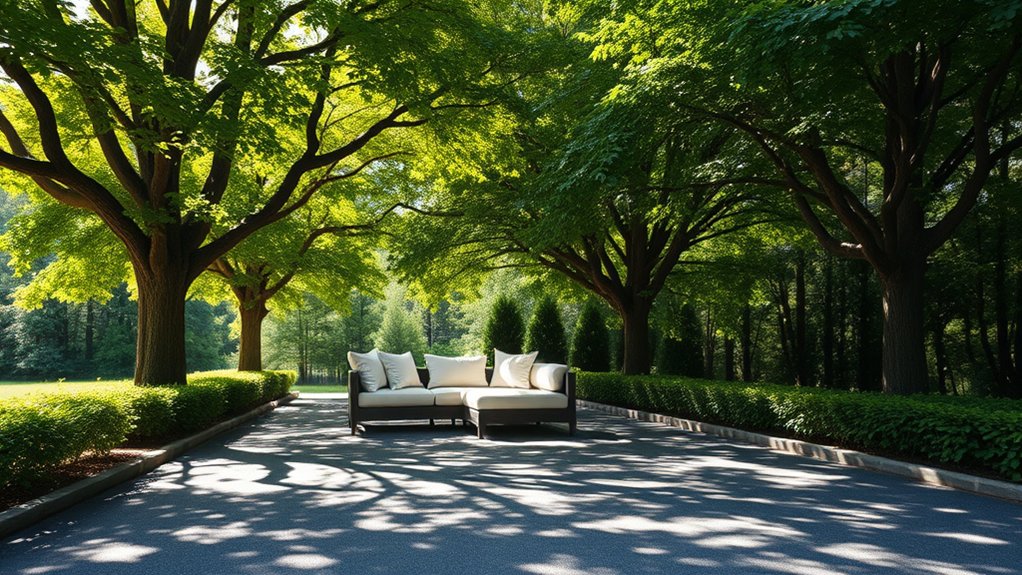
The role of shade in reducing heat on tarmac driveways is crucial. Properly positioned trees or artificial shade structures, like canopies, can significantly limit the tarmac’s exposure to direct sunlight. This not only cools the surface but also helps prevent UV damage over time.
When planning shade solutions, it’s important to consider the angle and position to ensure maximum coverage during peak sun hours. For instance, planting trees on the south or west side of the driveway can provide the best shade.
Additionally, incorporating shade with landscaping can enhance both functionality and appearance, creating a cooler environment and extending the lifespan of your driveway.
Innovative Cool Pavement Materials
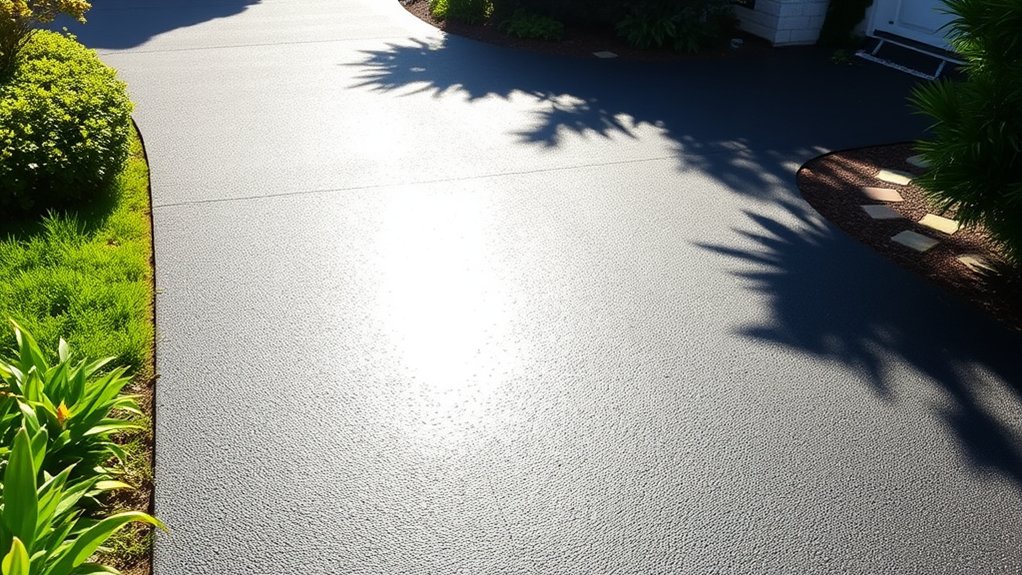
Shade solutions can help lower heat on tarmac driveways, but using innovative cool pavement materials takes heat management further.
These materials, made from water-based emulsions, polymers, and recycled content, boost surface reflectivity, significantly reducing heat absorption by bouncing sunlight away.
Cool pavements can lower surface temperatures by 10.5 to 12 degrees Fahrenheit during peak times, aiding urban sustainability by lessening the urban heat island effect.
While the initial cost, such as CoolSeal at approximately £40,000 per mile, may appear steep, the long-term benefits include lower maintenance expenses and enhanced safety.
Effective Sealcoating Techniques
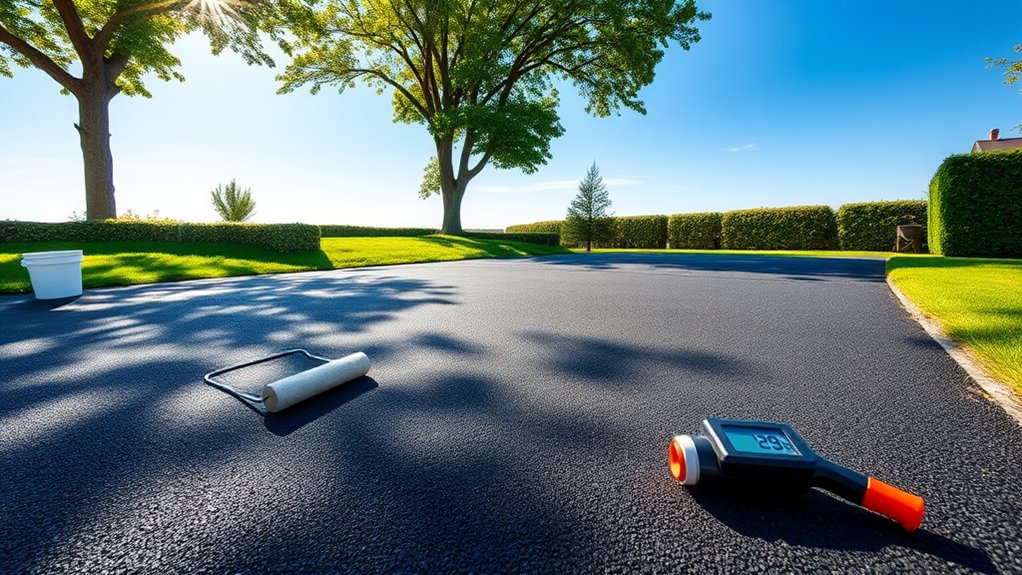
Effective sealcoating techniques are vital for extending the lifespan and performance of your tarmac driveway. By following proper methods, you can improve benefits like durability and heat resistance.
Here are three essential steps to consider:
- Preparation: Clean the surface thoroughly with a pressure washer and remove debris with a leaf blower. Treat any stains with a suitable degreaser and get rid of weeds using vinegar.
- Material Selection: Choose the appropriate sealant—an asphalt-based option for durability or coal tar for better water resistance, depending on your specific needs.
- Application: Apply the sealer in even layers, ensuring you overlap for consistent coverage. Allow adequate drying time between coats to ensure effectiveness. Proper maintenance, including regular sealcoating maintenance, is crucial for preventing heat absorption and prolonging the driveway’s lifespan.
Maintenance Practices for Heat Management
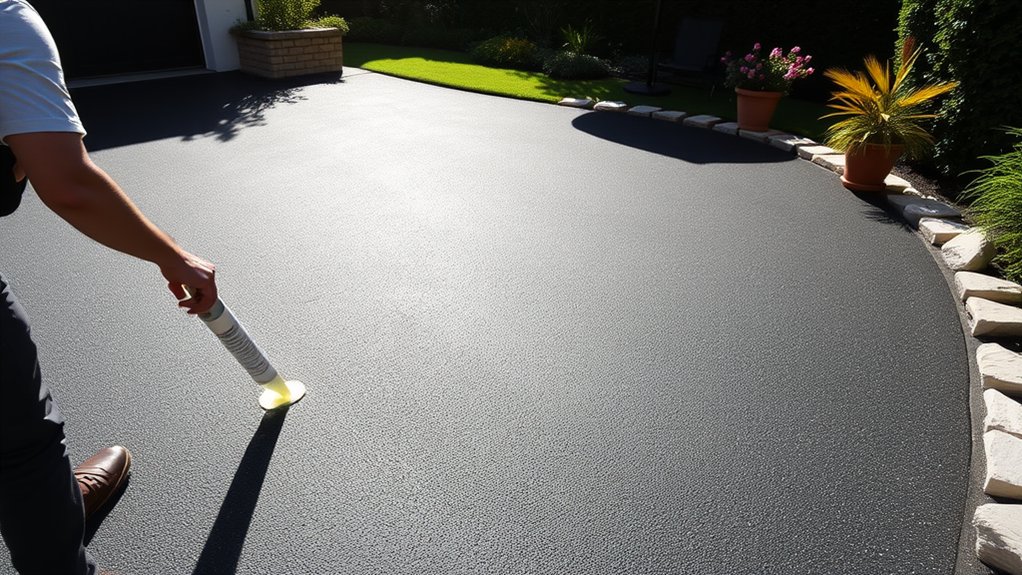
To manage heat on your tarmac driveway effectively, adopt these straightforward maintenance practices.
Start by planting trees or installing awnings to provide shade and reduce direct sunlight exposure.
Regular cleaning is essential; use a pressure washer to remove debris and maintain an even surface, which helps with thermal insulation.
Check for any cracks and apply a heat-reflective sealant to minimise heat retention.
It’s also wise to alternate parking spots to avoid excessive wear and limit heavy vehicle use during the hottest parts of the day.
Inform visitors about proper parking to help maintain the structure.
Schedule maintenance tasks during cooler periods to enhance repair efficacy without increasing heat exposure. Additionally, consider regular sealant application to preserve the surface and further reduce heat absorption.
These measures will help keep your driveway cooler and more durable.
Utilizing Water Cooling Techniques
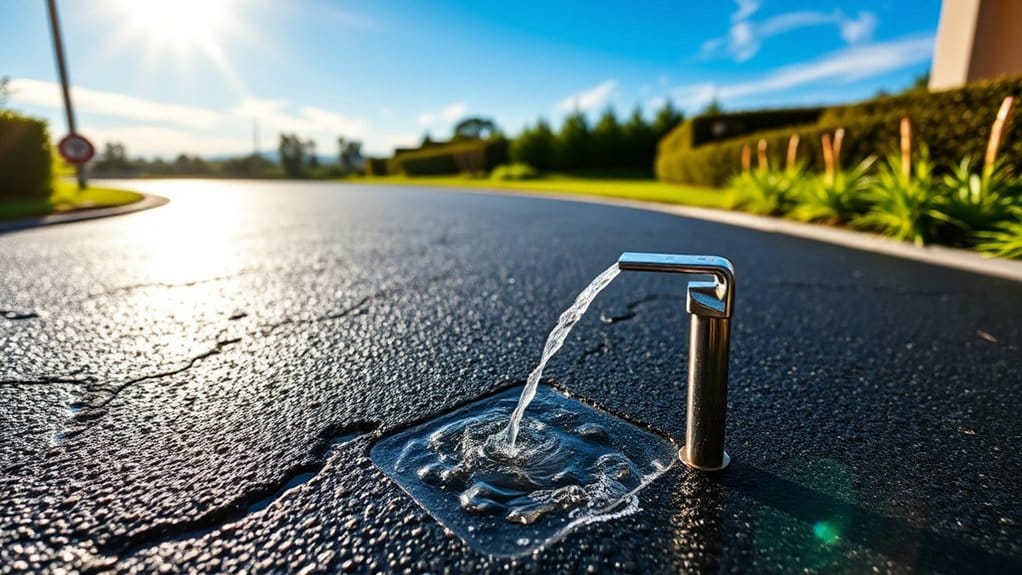
To improve heat management on your tarmac driveway, consider these water cooling techniques that also support water conservation:
- Spray cold water on the tarmac during the hottest parts of the day to lower surface temperatures and prevent damage.
- Direct natural runoff from gutters or water butts towards the driveway to help cool it, especially when it rains.
- Use reflective additives in your water sprays to enhance heat reflection, boosting the cooling effect.
These straightforward strategies can help keep your driveway cooler and more durable.
Seasonal Parking Strategies for Tarmac

As the seasons change, it’s crucial to adapt your parking strategies for tarmac driveways to ensure their longevity and performance.
In winter, use gentle de-icers to prevent damage to the surface.
In summer, prioritise parking efficiency; regular cleaning and sealing can help prevent softening from heat. Properly installed tarmac driveways can last 20 to 30 years with minimal upkeep.
Conduct bi-weekly inspections to catch cracks and potholes early, stopping further issues.
Stick to a sealcoating schedule every 2-3 years to protect against UV damage.
Also, consider renewing parking lot striping every 1-2 years for better visibility.
Growing Trees for Natural Shade

Choosing the right trees for natural shade can significantly lower heat absorption on tarmac driveways.
It’s important to consider their growth habits and how well they adapt to the environment. Here are some tree options for effective shade:
- Red Maple: Grows quickly, reaching up to 23 metres with a wide canopy.
- Shumard Oak: Nearly 30 metres tall, it provides substantial shade over large areas.
- Honeylocust: Produces dappled sunlight and thrives in poor soil and stormy conditions.
Ensure you plant these trees a safe distance from the driveway to avoid root damage.
They should also be suited to your local climate and resistant to pests.
Over time, these trees won’t only cool your driveway but also improve the look of your property and benefit local wildlife.
Temporary Shade Solutions: Awnings and Sun Shades
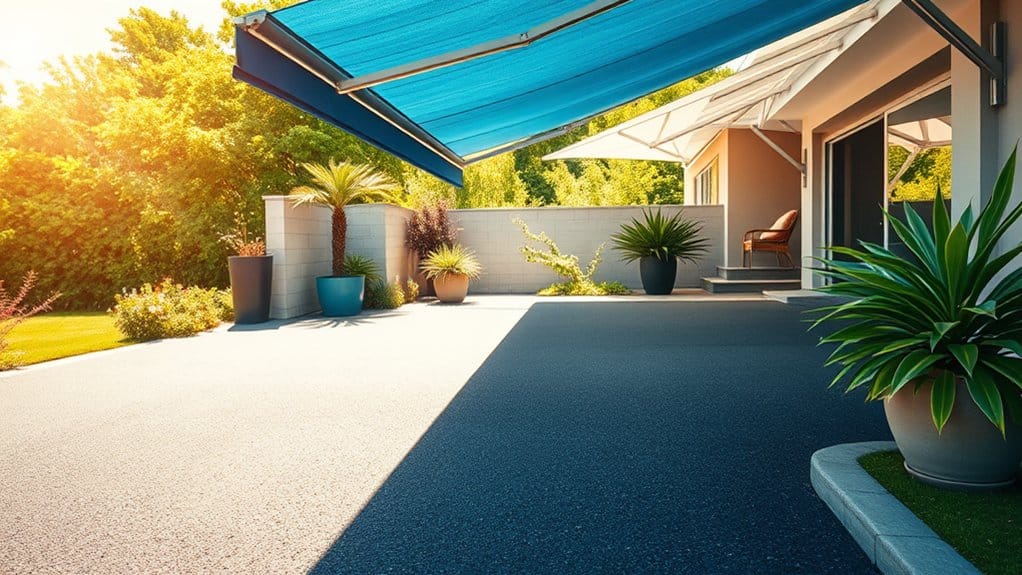
When looking for ways to reduce heat absorption on tarmac driveways, temporary shade solutions like awnings and sun shades are effective options.
Awnings can reduce solar heat gain by up to 77%, which can lower indoor cooling costs by around 25%. Their retractable design allows you to adjust the shade as the seasons change.
Sun shades also enhance outdoor spaces by blocking direct sunlight and improving comfort. Both options create cooler areas and can extend your living space, potentially increasing your property’s value.
Importance of Proper Drainage
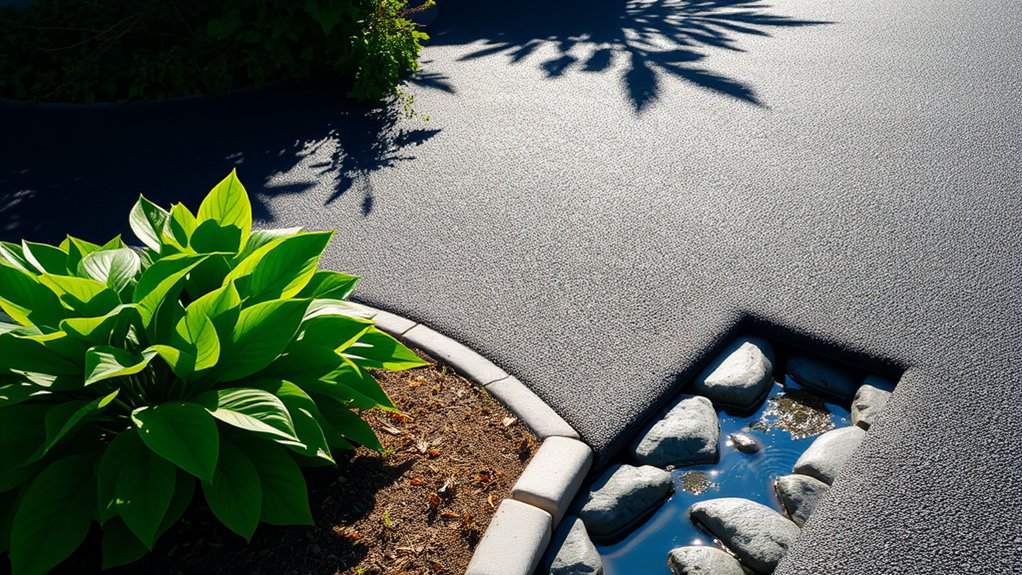
Proper drainage is vital to prevent standing water on your tarmac driveway, which can cause structural damage and surface deterioration.
By ensuring effective drainage, you can prolong the life of the asphalt and enhance its ability to cool, reducing heat absorption.
Regularly checking and maintaining your drainage systems will help avoid potential problems and keep your driveway in good condition over time.
Prevent Standing Water
To prevent standing water on your tarmac driveway, effective drainage solutions are essential. Proper water management helps avoid puddles and extends the life of your driveway.
Here are some key drainage techniques to consider:
- Surface Inspection: Regularly check for puddles or damp spots that may indicate poor drainage.
- Gutter Maintenance: Ensure gutters and downspouts are clear to stop overflow onto your driveway.
- Drainage System Checks: Make sure all drains are working properly and directing water away from the surface.
Enhance Asphalt Longevity
Effective drainage systems significantly improve the longevity of asphalt by preventing water-related damage that can weaken the surface. Key drainage techniques, such as proper surface grading and the installation of catch basins, are vital for managing water effectively.
These methods help reduce erosion, minimise the risk of freeze-thaw damage, and preserve the structural integrity of your asphalt. By guiding water to specific drainage points, you can lower repair expenses and extend the lifespan of your driveway.
Regular maintenance of these systems is crucial to ensure they operate effectively, preventing moisture build-up that leads to deterioration.
A well-designed drainage system not only enhances durability but also improves safety by reducing hazards associated with wet surfaces.
Improve Surface Cooling
Effective water management is crucial for any tarmac driveway, and it significantly enhances surface cooling. Implementing proper drainage solutions helps prevent water accumulation, making tarmac maintenance easier and extending the lifespan of your pavement.
Here are three main benefits of having an efficient drainage system:
- Prevents Damage: Good drainage stops erosion and reduces freeze-thaw damage, keeping your tarmac in good condition.
- Minimises Heat Absorption: Quick-drying tarmac reduces moisture, which in turn helps lower heat retention.
- Increases Stability: A well-designed drainage system directs water away from the surface, preventing issues such as raveling.
Regular Inspections and Swift Repairs
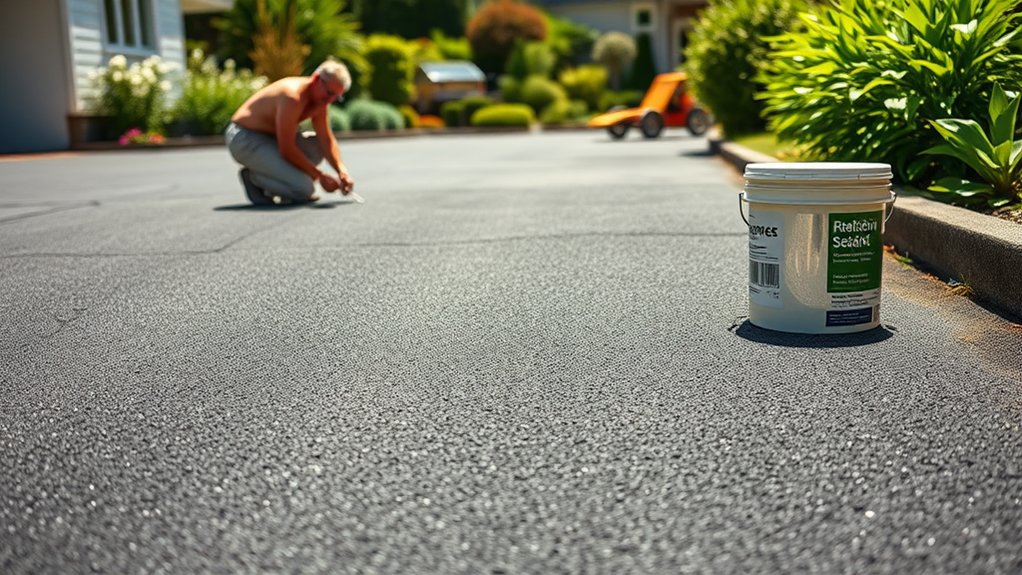
Regular inspections and prompt repairs are crucial for maintaining your tarmac driveway, particularly in areas that experience extreme heat.
Carry out inspections to spot cracks, soft spots, and potholes, as these can worsen in high temperatures. Check for debris build-up and the condition of the edges to avoid further damage. If you notice a problem, address it quickly.
Use quality sealants for cracks and appropriate products for pothole repairs. In hot weather, watering down the driveway can help reduce cracking caused by heat.
Aim for bi-annual inspections to assess damage before and after summer. Keeping detailed maintenance records will help track repairs and ensure your driveway remains resilient against heat.
Frequently Asked Questions
How Does Tarmac Heat Absorption Affect Vehicle Performance?
Tarmac temperature significantly affects vehicle engine performance. When the surface heats up, it can soften, which impacts tyre grip and increases friction. This not only reduces braking efficiency but also accelerates tyre wear, ultimately compromising vehicle handling and safety. For instance, on a hot summer day, you might notice your car doesn’t handle as well on the roads compared to cooler conditions.
Can Heat Absorption Lead to Structural Damage Over Time?
Heat absorption can indeed cause structural damage over time. As materials expand and contract with temperature changes, cracks can develop. For instance, asphalt may deteriorate, weakening its structure and leading to costly repairs if not addressed promptly. It’s essential to monitor and maintain surfaces to prevent these issues.
What Are the Environmental Impacts of High Heat Absorption in Tarmac?
High heat absorption in tarmac worsens urban heat, which in turn amplifies the effects of climate change. Rising temperatures lead to increased energy use, higher levels of air pollution, and negative impacts on human health. This situation disrupts local ecosystems and contributes to the loss of biodiversity. For instance, as urban areas heat up, wildlife may struggle to adapt, leading to diminished habitats and fewer species.
How Can I Tell if My Tarmac Is Overheating?
You may notice changes in the colour of the tarmac or soft patches underfoot—these are signs of overheating. A heat gauge can give you accurate readings, helping you determine if your driveway is reaching temperatures that could cause long-term damage.
Are There Specific Tarmac Materials That Resist Heat Absorption Better?
Yes, heat-resistant tarmac and reflective coatings are specifically designed to reduce heat absorption. These materials enhance surface reflectivity, which helps lower temperatures and improve durability. They are particularly useful for managing thermal stress in paved areas, such as car parks or driveways, where heat can build up significantly.
Conclusion
In summary, to reduce heat absorption in your tarmac driveway, you can use various methods, such as applying reflective coatings and creating shade. For instance, a homeowner in the south of England applied a reflective sealant and planted trees for shade, achieving a significant drop in surface temperature. By using these techniques, you not only improve comfort but also prolong the lifespan of your driveway. Regular maintenance and the use of innovative materials can effectively address heat-related issues, keeping your driveway functional and efficient.
Just how long can you expect your tarmac driveway to last? Discover key factors and maintenance tips that can extend Read more
From planning to final touches, discover the essential steps of tarmac driveway installation—what could go wrong if you skip any Read more
Wondering if a tarmac driveway is the perfect fit for your home? Uncover the essential pros and cons before making Read more


